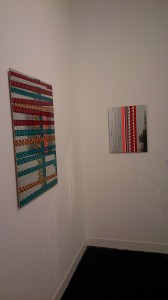On Thursday, when some of us have been at the fair for two days already, the whole character and temper of Frieze changes as it opens to the public. It feels less like a trade fair where experts walk around looking po-faced or lustful, and more like a cultural pageant for the bemused masses to gawp and gasp in wonder.
Walking past the queuing crowds into the fair, I was suddenly struck by the audacity of the Gagosian booth: devoting it to a single work by Carsten Holler is indicative of the fact that Gagosian only goes to Frieze to be seen, having no need to either offer high profile publicity to its variety of artists. Of course, much of the dealing goes on behind the scenes before and after the fair, not to mention that they are selling more than just what’s on show, but to focus the booth so narrowly is a gesture that many galleries can only dream of having the luxury to afford.
Michael Werner Gallery [A6] has one of the most delightful pieces in the entire fair, which detained my attention for some time today and on Tuesday. James Lee Byars’ 10 in a Hat consists of ten people wearing shockingly pink fabric hats that are joined together: they are a metaphor for society, all individuals but connected by a thread that ensures their movements must be at least minimally co-ordinated. They walk around and look at things, they smile ever so sweetly and answer questions; sometimes they sit or lay down, sometimes they laugh. None of it is choreographed; it is a performance that has no rules or boundaries, where ten people – men and women of all ages – just simply Be. The price of this delicious existential conceit is a bargain at £300,000, for which you get the original 1969 ten hat set and a licence to use it wherever and whenever you please. Definitely one to watch out for – if you see them, stop and chat to them, they’re lovely people and probably aren’t being paid anywhere near enough for the joy they are spreading.
The Focus section, dedicated to smaller galleries, is remarkable this year. Nestled away in a far corner of the tent, it is the reward for having bravely trawled through so much commercial art. Here the art looks like art rather than like cash generators. Croy Nielsen of Berlin [G16] is showing a piece by Nina Beier which is comprised of organic vegetables strewn across the floor, spilling from some plastic green grocer’s crates. Francois Ghebaly [G12] has two stunning paintings by Sayre Gomez, who has airbrushed black acrylic over yellow to create a splotchy impression of chaos from a highly controlled process. A work by Sean Raspet at Societe [G15] engages the senses: huge, translucent plastic barrels containing a solution of artificial banana flavouring that is popular in the United States but banned in the EU fills the fair with a smell that is at once captivating and repugnant. Brussels-based gallery, dependence [G17], has one of Richter’s Grau paintings, which seem standard issue this Frieze, but it also has a beguiling two metre square painting of a plug socket, titled Where the energy comes from, by Jana Euler. The entire Focus section reminds one of what art looks like when it is not trying too hard, but is quietly just being art in all its varied forms; it has the whimsy and caprice that makes art inspiring and edifying. It is the kind of art that does not immediately make sense, but nor does it alienate, it is simply an object of contemplation and aesthetic pleasure.
It was funny today because all the gallerists, hustlers, journalist and artworld groupies were looking hungover and tired, exhausted by the onslaught because they have been at it for days already. I overheard one guy, a cute young American who was obviously part of some performance, complaining about how he accidently got drunk every night. But the crowds of ticket-holders were buoyant with intrigue; it was refreshing to see people – normal people rather than hedgefund managers – enjoying the splurge of contemporary art. There were also artists around today. Theaster Gates seemed to remember me from a previous meeting, so we chatted about his Tar Paintings and the British weather. And Mona Hatoum floated around looking glacially glamorous and spoke immensely politely to an elderly couple who behaved as if they’d just met Elvis.
I have not had much time to absorb the live programme, but Isabel Lewis at the ICA Offsite has stuck in my mind. I cannot forget the way she co-opted her audience into phenomenological discussion about the sensation of smell and then turned effortlessly to an eloquent discourse on David E Cooper’s Philosophy of Gardens. But today I did catch a glimpse of Adam Linder [L5], who stood facing a wall and spoke of ‘contemporary art problems’. It was a stark moment of pristine choreography that made one wonder whether – in all the hubris and money – if anyone has considered that contemporary art might have a problem. The problem, if there is one, is that there’s too much to see and no way of knowing if any of it is any good until you’ve wasted time seeing it.
As I was plodding my way out, art-blind and achy, I caught site of two shimmering works by Isa Genzkin at the Galerie Bucholz stand [C10], which refuelled my fire with their unlikely collision of bling and intelligence. The problem, I realised, is that no matter how many times you walk round the fair, you’ll always end up missing something that you’d like to stare at all day.
Words: Daniel Barnes




